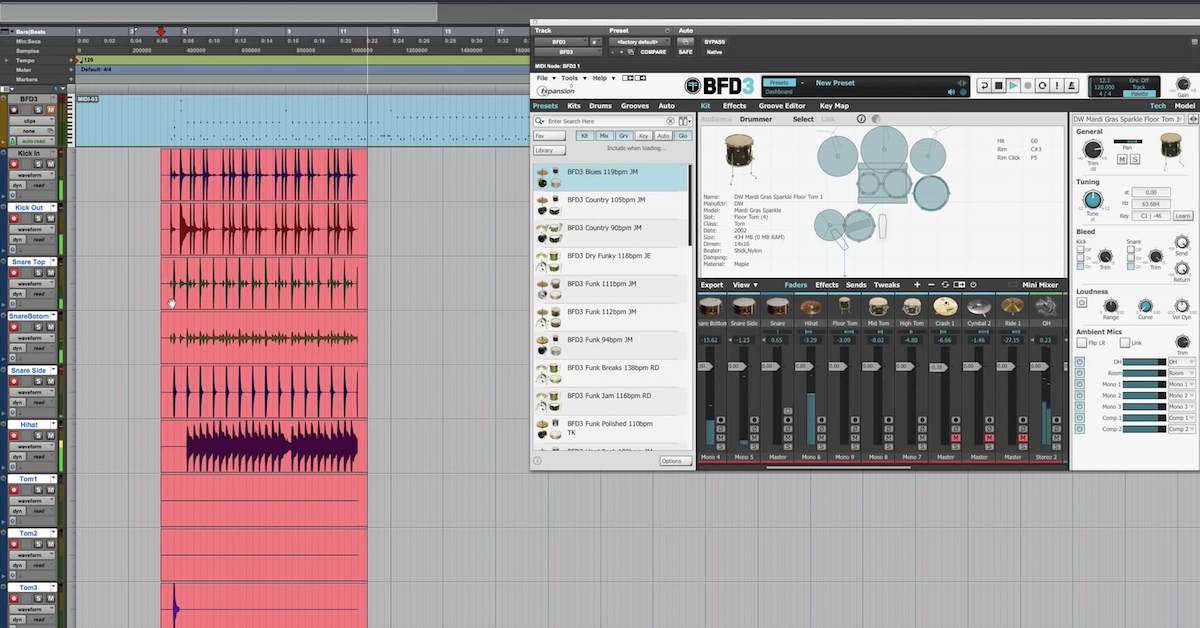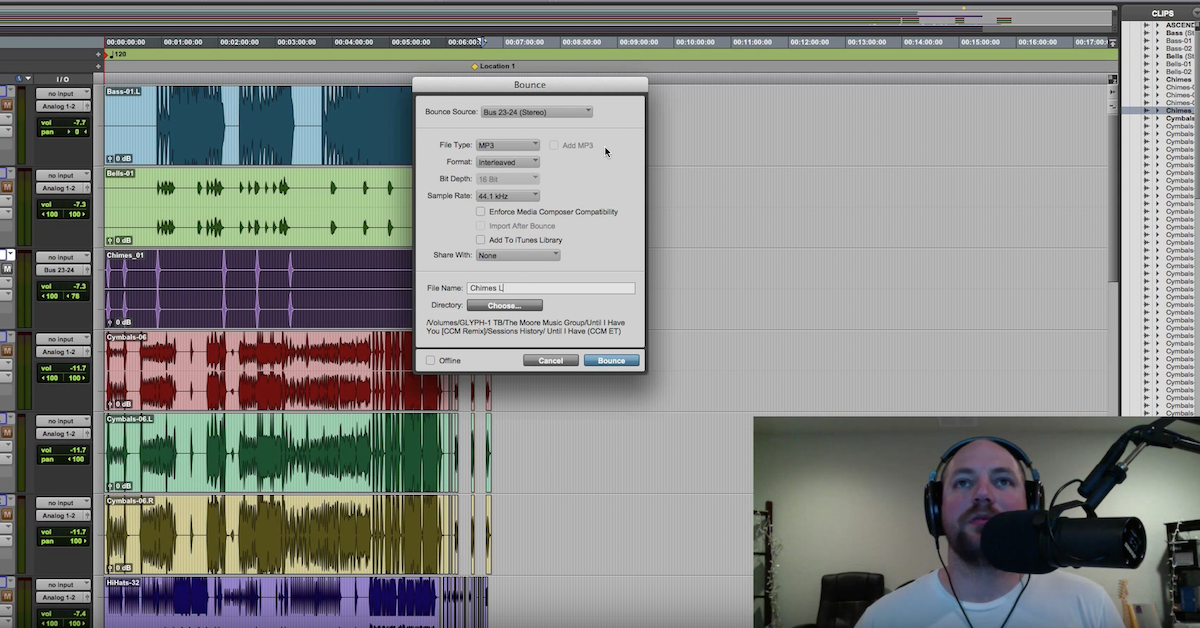How to Archive Multitrack DAW Recordings
Article Content
Multitrack DAW recordings are dependent on a complex system of primary and secondary technologies. As discussed in An Introduction to Archiving Music Recordings, each of these technologies represents an obstacle to the long-term viability of a multitrack archive.
Simply put, if the various software and hardware products you’re using today aren’t going to be around in their current versions for the useful life of the sound recordings you’re creating (i.e. the copyright term), the archived recording must be prepared to weather that obsolescence. The goal of preparing multitrack DAW data for archive is to minimize the layers of technology necessary to completely reconstruct the master recording in the future.
This article will introduce some basic techniques for creating both Consolidated and Flat Multitracks for archival purposes.
What is a Consolidated Multitrack?
A Consolidated Multitrack is a digital audio fileset that completely expresses the EDL (Edit Decision List) information from a multitrack master recording. Specifically:
- Each DAW track is expressed as a single, continuous Broadcast Wave file (BWF);
- All of the consolidated audio files share the same start times and durations;
- All of the consolidated audio files share the same digital audio precisions, i.e. sample rate and bit depth;
- All of the consolidated audio files share the same descriptive naming convention, e.g. trackname_songtitle_artistname.wav.
If all of the above specifications are met, a folder containing the consolidated audio files could be used to perfectly reconstruct the multitrack recording as far into the future as the Broadcast Wave file format remains viable.
Since the Broadcast Wave file is a widely accepted standard file format for media producers, its long-term viability (and eventual uniform migration) is virtually guaranteed.
Creating a Consolidated Multitrack:
- From your last active session/project file, ‘Save As’ to create a discrete file from which you will create a Consolidated Multitrack.
- Hide or delete any auxiliary signal path to simplify the working environment.
- If additional Takes or Playlists are to be included in the Consolidated Multitrack, create new tracks to allow all of the source audio to be simultaneously visible/accessible.
- Using session boundaries, location markers, or some other timeline tool, establish a repeatable global timeline selection that includes all audio from the earliest drop-in to beyond the longest running audio file.
- Once your global selection is made, use the Consolidate or Merge functions to create a single continuous audio file that expresses the EDL information for each track.
- Carefully, consistently label all of the newly consolidated audio files to reflect enough information that they could completely identify themselves by name, e.g. bassamp_take2_ohbabybaby_jimmysingsalot.wav
Once the above steps have been followed, a choice has to be made about how to present these consolidated audio files as a discrete multitrack recording for archive.
Minimally, a folder that follows the same naming convention as the consolidated audio files should be created to contain all of the associated audio files and metadata (like screen shots, rtf files containing session notes, credits, etc.). This method works fine, but will always require the multitrack to be reconstructed in a DAW for playback.
Alternately, a facility like Pro Tools’ ‘Save Session Copy’ could be used to create a new, independent playback session for only the archival material. Using this method one would need to be careful to remove any non-archival audio and metadata from the source session before saving the copy. This approach would facilitate more convenient short-term use of the archive, but doesn’t actually provide any additional content.
What is a Flat Multitrack?
A Flat Multitrack is a digital audio fileset that completely expresses the EDL information from a multitrack master recording, but also expresses some subset of DAW metadata. What metadata is ‘flattened’ into the archive is up to you, your client, or contractual obligations, but it could include:
- Plug-in processing like amp simulation, ‘printed’ effects from auxiliary channels, or automated processing;
- Automation data, like the fader rides on a lead vocal track;
- Bounced submixes that would otherwise require reconstructing both complex routing and plugin processing.
It is critically important to note that a Flat Multitrack should never be archived instead of a Consolidated Multitrack, but only in addition. The Consolidated Multitrack is the master recording; the Flat Multitrack (when applicable) is an extension of that master.
Creating a Flat Multitrack:
Once a Consolidated Multitrack has been created, a Flat Multitrack can be created by repeating the process with a few additional steps:
- From your last active session/project file, ‘Save As’ to create a discrete file from which you will create a Flat Multitrack.
- Hide or delete all auxiliary signal path and metadata that is not going to be flattened.
- If additional Takes or Playlists are to be included in the Flat Multitrack, create new tracks to allow all of the source audio to be simultaneously visible/accessible.
- To flatten real-time processes like automation, time-based effects, or submixing, bounce/re-record the appropriate track outputs to new tracks, and remove the source tracks from the session. Note what metadata has been flattened.
- Flatten additional metadata by processing audio files with offline versions of real-time plug-ins. Note what metadata has been flattened.
- Make a global timeline selection, and use the Consolidate or Merge functions to create a single continuous audio file that expresses the EDL information for each track (including whatever metadata has been flattened into them).
- Carefully, consistently label all of the newly consolidated audio files to reflect enough information that they could completely identify themselves by name, e.g. bassamp_take2_flatcompression_ohbabybaby_jimmysingsalot.wav
Since it would be unlikely that every track within a DAW project would have metadata worth flattening, there will likely be some tracks that remain in their consolidated form. I would caution that it would be both redundant and confusing to include these audio files in a Flat Multitrack archive.
Preferably, an additional folder of flattened audio files can be clearly labeled, and organized with the Consolidated Multitrack data. Future users can then reconstruct the Consolidated archive, and opt-in to any of the available, clearly labeled, flat content.
Contents Versus Carrier
It should be noted that this tutorial only addresses the form of the contents of a multitrack archive. The question of how to effectively store this information is an entirely additional- though related- matter.
Anybody who is serious about the subject should examine the Producer and Engineers Wings’ “Recommendation for Delivery of Recorded Music Projects”. It contains an example of a widely-adopted approach to redundant archival storage.






